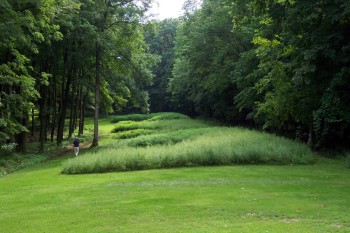Visit Effigy Mounds, Hoover’s birthplace and the Lewis and Clark, and Mormon Pioneer Trails
By John Skipper
It’s no secret there are no mountains in Iowa, nor any oceans or skyscrapers. But anyone who has taken a plane ride over the state has looked down upon patchworks of green and yellow that are a part of nature’s glorious quilt of rich land and soil that cannot be found in New York, Chicago, Los Angeles, or any of the big cities that often steal the headlines telling tourists where to go and what to see.

The Marching Bear Mounds and others at Effigy Mounds National Monument in Harpers Ferry are considered sacred by many Americans, especially the monument’s associated American Indian tribes. Photo courtesy of the National Park Service
The National Park Service (NPS), which knows a thing or two about history, heritage, culture and preservation, has designated four areas of Iowa as national treasures. They are unique for vastly different reasons. Each tells a story of who we are and what we’ve done from prehistoric times up to today.
The Effigy Mounds National Monument in Harper’s Ferry, the Herbert Hoover National Historic Site in West Branch and two national historic trails — the Lewis and Clark Trail along the Missouri River and the Mormon Pioneer Trail stretching across the state from east to west — are special to Iowa and the nation’s history.
In commemoration of the 100th anniversary of the National Park Service (NPS), here is a glimpse of Iowa’s contributions to the historic and beautiful sites that the NPS maintains and preserves so the public can enjoy them. You might consider visiting one or more of them when making plans for your summer vacation. For more information, visit www.nps.gov.
Lewis and Clark Trail
Eager to open the West to settlement, President Thomas Jefferson commissioned Captains Meriwether Lewis and William Clark to explore the newly acquired Louisiana Territory. With a crew of 40, they set out in 1804 and went on a journey that took them through 11 states, covering 3,700 miles from the Mississippi River to the Pacific Ocean. It took them two years. Along the way, Lewis and Clark mapped their journey and created a record of the natural resources they encountered. They also made contacts with Native Americans.
Visitors can now follow their journey along the Missouri River through Iowa. It was in Iowa that the two men held council with chiefs of the Missouri and Oto Indian tribes at a place they named Council Bluffs. One can only imagine the feeling they had as they steered their keelboat west and north and saw, beyond the shoreline, the greens and yellows of the landscape and the rich soil beneath them.
TO READ MORE ABOUT THIS STORY AND OTHER FASCINATING STORIES ABOUT IOWA HISTORY, subscribe to Iowa History Journal. You can also purchase back issues at the store.
